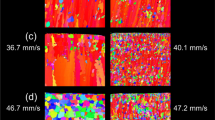Abstract
The use of resistance spot welding (RSW) technology for joining Ti40Zr25Ni3Cu12Be20 metallic glass was investigated. The microstructure obtained from the welded BMG sample was studied. Joint without precipitates was prepared with welding current of 5.0 kA for 2 cycles. A fully coupled thermal–electrical–mechanical finite element model (FEM) was developed to complement the experimental study. The simulated results agree well with the measurements. The effects of key process parameters such as welding current and welding time on the evolvement and microstructure of the weldment were determined and discussed. Moreover, the critical cooling rate for preserving the amorphous state in the weld fusion zone is determined to be approximately 1 × 103 K·s−1.






Similar content being viewed by others
References
Sun BR, Zhan ZJ, Liang B, Zhang RJ, Wang WK. Fracture characteristics of bulk metallic glass under high speed impact. Chin Phys B. 2012;21(5):056101.
Huang LJ, Wang YX, Tang JG, Wu DC, Wang Y, Liu JX. Capacity fading mechanism for Mg-based amorphous electrode alloys. Chin J Rare Metals. 2013;37(1):14.
Li YH, Zhang W, Dong C, Makino A. Effects of Cu, Fe and Co addition on the glass-forming ability and mechanical properties of Zr-Al-Ni bulk metallic glasses. Sci China Phys Mech Astron. 2012;55(12):2367.
Fuijwara K, Fukumoto S, Yokoyama Y, Nishijima M, Yamamoto A. Weldability of Zr50Cu30Al10Ni10 bulk glassy alloy by small-scale resistance spot welding. Mater Sci Eng A. 2008;498(1):302.
Makhanlall D, Wang G, Huang YJ, Liu DF, Shen J. Joining of Ti-based bulk metallic glasses using resistance spot welding technology. J Mater Process Technol. 2012;212(8):1790.
Shin HS, Jung YC. Characteristics of friction stir spot welding of Zr-based bulk metallic glass sheets. J Alloys Compd. 2010;504(1):S279.
Wang HS, Chen HG, Jang JSC. Microstructure evolution in Nd:YAG laser-welded (Zr53Cu30Ni9Al8)Si0.5 bulk metallic glass alloy. J Alloys Compd. 2010;495(1):224.
Wang G, Huang YJ, Shagiev M, Shen J. Laser welding of Ti40Zr25Ni3Cu12Be20 bulk metallic glass. Mater Sci Eng A. 2012;541(1):33.
Shin HS, Park JS, Yokoyama Y. Dissimilar friction welding of tubular Zr-based bulk metallic glasses. J Alloys Compd. 2010;504(1):S275.
Wang D, Xiao BL, Ma ZY, Zhang HF. Friction stir welding of Zr55Cu30Al10Ni5 bulk metallic glass to Al-Zn-Mg-Cu alloy. Scripta Mater. 2010;60(2):112.
Eisazadeh H, Hamedi M, Halvaee A. New parametric study of nugget size in resistance spot welding process using finite element method. Mater Des. 2010;31(1):146.
Khan JA, Xu L, Chao YJ, Broach K. Numerical simulation of resistance spot welding process. Numer Heat Transf A. 2000;37(5):425.
Huh H, Kang WJ. Electrothermal analysis of electric resistance spot welding processes by a 3-D finite element method. J Mater Process Technol. 1997;63(3):672.
Gould JE, Khurana SP, Li T. Predictions of microstructures when welding automotive advanced high-strength steels. Weld J. 2006;85(3):111s.
Ma N, Murakawa H. Numerical and experimental study on nugget formation in resistance spot welding for high strength steel sheets in automobile bodies. Trans JWRI. 2009;38(2):19.
Liu TJC. Thermo-electro-structural coupled analysis of crack arrest by Joule heating. Theor Appl Fract Mech. 2008;49(1):171.
Wang X, Casolco SR, Xu G, Garay JE. Finite element modeling of electrical current-activated sintering: the effect of coupled electrical potential, temperature and stress. Acta Mater. 2007;55(10):3611.
Acknowledgments
This work was financially supported by the National Natural Science Foundation of China (No. 50904021), the Naural Science Foundation of the Education Department of Anhui Province (No.KJ2014A023) and the Scientific Research Starting Foundation of Anhui Polytechnic University (No.2012YQQ006).
Author information
Authors and Affiliations
Corresponding author
Rights and permissions
About this article
Cite this article
Wang, G., Huang, YJ., Makhanlall, D. et al. Resistance spot welding of Ti40Zr25Ni3Cu12Be20 bulk metallic glass: experiments and finite element modeling. Rare Met. 36, 123–128 (2017). https://doi.org/10.1007/s12598-014-0354-8
Received:
Revised:
Accepted:
Published:
Issue Date:
DOI: https://doi.org/10.1007/s12598-014-0354-8




